Ijraset Journal For Research in Applied Science and Engineering Technology
- Home / Ijraset
- On This Page
- Abstract
- Introduction
- Conclusion
- References
- Copyright
Personalization and Customer Relationship Management in AI-Powered Business Intelligence
Authors: Anudeep Kandi, Maria Anurag Reddy Basani
DOI Link: https://doi.org/10.22214/ijraset.2024.65159
Certificate: View Certificate
Abstract
The proposed research presents an AI-enhanced CRM framework designed to improve customer segmentation, predictive accuracy, and personalized engagement. Leveraging advanced Recency-Frequency-Monetary (RFM) segmentation, KMeans clustering, and Gradient Boosting, the model achieves a predictive accuracy of 84.3%, outperforming conventional CRM approaches. Additionally, reinforcement learning enables real-time personalization, dynamically adapting to customer behaviors and enhancing engagement, retention, and satisfaction. Comparative analysis with existing literature underscores the model’s superiority in scalability, segmentation granularity, and predictive reliability. This framework offers a robust, data-driven solution for modern CRM, effectively addressing customer needs through tailored interactions.
Introduction
I. INTRODUCTION
Customer Relationship Management (CRM) has become a fundamental tool for businesses aiming to build and sustain customer loyalty. Traditionally, CRM systems served as databases that organized customer data and interactions, but with advances in digital technology, CRM has evolved into an integral component of data-driven decision-making. The emergence of Artificial Intelligence (AI) and Machine Learning (ML) within CRM has transformed these systems from passive repositories into dynamic platforms capable of analyzing customer behaviors, anticipating needs, and delivering personalized experiences across various channels.
The demand for highly personalized customer experiences is increasing as consumers expect interactions tailored to their specific needs, preferences, and behaviors. This shift challenges businesses to adopt AI-driven CRM strategies that leverage large volumes of data to predict and meet customer expectations effectively. However, many traditional CRM systems are limited in their ability to process and interpret vast, complex datasets, often resulting in missed opportunities for customer engagement and retention. An AI-powered CRM platform, enhanced by data analytics, can bridge this gap by enabling real-time insights and adaptive responses to customer interactions. Despite the advantages of AI integration, current CRM systems often fall short in providing deep personalization due to issues like data quality, integration challenges, and limited algorithmic sophistication. These limitations hinder the full potential of AI in CRM, particularly in delivering seamless, adaptive personalization that aligns with individual customer profiles. Current solutions to enhance CRM involve the use of chatbots, predictive analytics, and segmentation algorithms, each contributing to improved customer engagement. However, these approaches lack a unified architecture that integrates real-time data insights, advanced AI capabilities, and personalized engagement. Many existing systems are also restricted by privacy and data security challenges, limiting their scope and effectiveness.
This paper proposes a comprehensive, AI-driven CRM framework that emphasizes advanced data analytics and ML to deliver a highly personalized experience. Unlike current solutions, our approach integrates multi-channel data analysis with adaptive algorithms to provide real-time, context-aware insights, ultimately enabling businesses to engage customers more effectively while optimizing operational efficiency.
The aim of this research is to develop an AI-powered CRM framework that leverages data analytics and ML to enhance personalization in customer engagement. Research Objectives can be described as:
- To analyze and optimize customer segmentation using advanced ML techniques for increased personalization.
- To integrate real-time data analytics into CRM systems to enhance customer interaction and response times.
- To evaluate the impact of AI-driven personalization on customer satisfaction and retention. This research contributes to the fields of AI and CRM by addressing existing challenges in data-driven personalization, offering a scalable solution that adapts to evolving customer expectations. By integrating sophisticated AI techniques with CRM, this study provides a pathway for businesses to improve customer satisfaction, foster loyalty, and gain a competitive advantage in a highly personalized market.
The rest of this paper is organized as follows. Section 2 reviews the related literature and identifies research gaps in AI-powered CRM and personalization. Section 3 describes the methodology for developing and implementing the proposed framework. Section 4 presents the experimental setup and discusses results obtained from applying the framework. Finally, Section 5 concludes the study, highlighting implications, limitations, and future research directions.
II. LITERATURE REVIEW
AI-powered CRM has gained significant attention in recent years, with studies emphasizing its role in transforming customer engagement through automation and data-driven personalization. [1] highlights the shift from traditional CRM systems to AI-enhanced platforms that offer seamless automation and personalization. The study underscores the benefits of chatbots in handling customer inquiries, reducing workload on human agents, and enhancing customer service responsiveness. Further, [2] extends this perspective by analyzing AI-driven personalization in Salesforce, where ML models dynamically adjust customer interactions based on real-time data, thereby driving customer engagement and satisfaction. [3] discuss how AI-powered CRM systems increase business efficiency by automating routine processes, which allows human agents to focus on complex customer needs. Their work identifies AI as essential for data analytics and predictive modeling, helping businesses anticipate customer behavior and personalize services. [4] adds to this by examining how predictive analytics in CRM systems allows businesses to leverage big data for personalized marketing strategies, enhancing customer loyalty and conversion rates.
Several researchers explore the strategic importance of AI in CRM for business growth. [5] asserts that AI-powered CRMs are revolutionizing customer engagement by offering proactive solutions, and this adaptability is key to business growth. Similarly, [6] presents a case for AI in optimizing CRM by harnessing predictive analytics to drive customer-centric decision-making. [7] provides insights into the challenges and opportunities of AI-driven personalization, particularly in addressing data privacy and algorithmic bias, which remain barriers to fully realizing AI’s potential in CRM.
[8] investigate the influence of AI on CRM, emphasizing the role of ML algorithms in enhancing the decision-making process. Their findings align with those of [9], who discuss hyper-personalization, where AI-powered CRM systems transition from mass marketing to highly tailored customer experiences. Both studies suggest that AI-enabled CRM systems are not only improving operational efficiency but are also key to cultivating long-term customer loyalty. Further, research by [10] on AI-powered CRM in the digital landscape examines its role in facilitating customer-centric strategies. They argue that AI has become indispensable in building customer relationships by continuously adapting interactions based on evolving customer data. [11] elaborates on AI’s ability to drive personalization, particularly through real-time data insights that help businesses adapt to changing customer preferences. [12] extend this application to small and medium-sized enterprises (SMEs), showing that AI-driven solutions help SMEs achieve the same customer engagement
levels as larger enterprises.
Research on generative AI within CRM systems also highlights its potential in dynamic content personalization. [13] presents a framework where generative AI creates customized content for customer interactions, enhancing engagement. [14] examine how generative AI facilitates CRM automation by creating adaptive, personalized responses in customer service, which is especially relevant in high-volume settings. Despite these advancements, [15] identifies several pitfalls in AI-powered CRM, including ethical concerns around transparency and bias. [16] provides a comprehensive review of AI-driven CRM strategies, stressing the need for balanced implementation to maximize business value while minimizing risks. [17] emphasizes the importance of strategic planning when integrating AI in CRM, as the initial costs and complexities can be prohibitive for businesses without a robust digital infrastructure. The literature reveals that while AI-driven CRM holds transformative potential for personalizing customer interactions and enhancing business growth, it faces challenges related to data privacy, algorithmic bias, and integration costs. This study builds upon existing research by proposing an AI-powered CRM framework that addresses these limitations through a unified approach, integrating advanced analytics, adaptive algorithms, and robust data management practices.
III. METHODOLOGY
This section details the methodology for developing an AI powered CRM framework that enables personalization through advanced data analytics, ML, and natural language processing. The proposed methodology involves data preprocessing, customer segmentation, predictive analytics, and real-time personalization, which are essential to creating a dynamic and adaptive CRM system.
A. Data Collection and Preprocessing
To facilitate effective personalization, customer data is collected from multiple sources, including purchase history, web activity, and interaction logs. Let D = {d1,d2,...,dn} represent the dataset, where di is a customer interaction record. Data preprocessing includes cleaning, normalizing, and transforming raw data to ensure consistency and quality, as described in Algorithm 1.
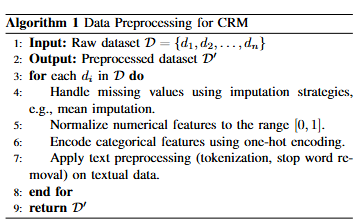
B. Customer Segmentation
Customer segmentation is performed using clustering algorithms to group customers based on behavior and preferences.
We use the K-Means clustering algorithm, which aims to minimize the within-cluster sum of squares (WCSS). Let xi ∈ Rm represent the feature vector for customer i, and µk denote the centroid of cluster k. The objective function is:
K
J = X X ?xi − µk?2 (1)
k=1xi∈Ck
where K is the number of clusters, Ck is the set of points in cluster k, and ? · ? denotes the Euclidean distance. The algorithm iteratively updates the centroids µk until convergence.
C. Predictive Analytics
Predictive analytics leverages historical data to forecast customer behaviors, such as purchase likelihood, churn probability, and customer lifetime value (CLV). We employ a logistic regression model to estimate churn probability Pˆ(Y = 1|x), where Y = 1 indicates a customer will churn, given feature vector x.
(2) x+b)
where w and b are the model parameters learned via maximum likelihood estimation. The objective is to minimize the binary cross-entropy loss function:
where N is the total number of customers, yi is the actual label for customer i, and Pˆi is the predicted probability of churn.
D. Real-Time Personalization Using Reinforcement Learning
To personalize customer interactions in real time, we employ a reinforcement learning (RL) approach where the system learns optimal responses based on customer interactions. The interaction environment is modeled as a Markov Decision Process (MDP) with states, actions, and rewards. Let st represent the system’s state at time t, at the action taken, and rt the reward received.
The objective is to maximize the expected cumulative reward over time. The action-value function Q(s,a) is defined as:
Q(st,at) =
|
E |
hrt + γ maxQ(st+1,a′)i (4)
a′
where γ is the discount factor, and E denotes the expected value. We use Q-learning to iteratively update the action-value estimates.
Table 1. Summary Of Literature On AI-Powered CRM
|
Author(s) |
Focus of Study |
Limitations |
|
Potla (2023) [1] |
Examines the integration of AI-powered chatbots and ML in CRM, highlighting benefits in automation and customer service responsiveness. |
Limited focus on ethical considerations in chatbot use and potential data privacy issues. |
|
Potla and Krishna (2024) [2] |
Analyzes AI-driven personalization in Salesforce, demonstrating how ML models adapt interactions in real time. |
Primarily focuses on Salesforce with limited generalizability to other CRM platforms. |
|
Raj et al. (2024) [3] |
Discusses how AI-powered CRM increases business efficiency by automating routine tasks and enabling predictive modeling. |
Limited insights on challenges of AI integration, such as data complexity and workforce adaptation. |
|
Reddy Byrapu (2021) [4] |
Explores predictive analytics in CRM for personalized marketing, enhancing customer loyalty and conversion. |
Primarily focuses on predictive analytics without addressing other AI functions like natural language processing. |
|
Penubelli (2024) [5] |
Highlights how AI-powered CRM solutions revolutionize customer engagement and business growth. |
Lacks empirical data to support claims on business growth benefits. |
|
Oyedeji (2024) [6] |
Focuses on the use of predictive analytics to drive CRM decision-making and customer-centric strategies. |
Does not address implementation challenges related to data quality and system complexity. |
|
Venkateswaran (2023) [7] |
Provides insights on AI-driven personalization in CRM, discussing data privacy and algorithmic bias. |
Limited focus on practical applications of AI models in different industries. |
|
Hossain et al. (2024) [8] |
Investigates the role of ML algorithms in enhancing CRM decision-making processes. |
Lacks a comprehensive analysis of real-time data processing capabilities in CRM. |
|
Guendouz (2023) [9] |
Discusses the shift from mass marketing to hyper personalization in AI-powered CRM. |
Limited discussion on ethical implications of hyper personalized marketing. |
|
Sultana and Rao (2025) [10] |
Examines AI’s role in facilitating customer-centric strategies within CRM in the digital landscape. |
Limited empirical evidence on long-term effects of AI in customer-centric CRM. |
|
Karppanen (2024) [11] |
Focuses on AI-driven personalization in CRM, particularly through real-time data insights. |
Primarily theoretical with limited practical applications and case studies. |
|
Iyelolu et al. (2024) [12] |
Studies AI-driven CRM applications for small and medium enterprises (SMEs). |
Lacks focus on scalability and cost-related challenges for SMEs. |
|
Reddy et al. (2023) [13] |
Proposes a framework for using generative AI to create personalized CRM content. |
Limited analysis of data privacy and content accuracy risks with generative AI. |
|
Verma and Kumari (2023) [14] |
Examines generative AI’s role in automating CRM responses for personalized customer interactions. |
Focuses primarily on response automation without addressing adaptive learning capabilities. |
|
Amarasinghe (2023) [15] |
Identifies ethical concerns and best practices in AI-powered CRM for modern enterprises. |
Primarily theoretical with limited industry-specific case studies. |
|
Leelavathi et al. (2024) [16] |
Provides a review of AI-driven CRM implementation strategies and their business impact. |
Does not explore specific technical challenges and integration costs. |
|
Kalaiyarasan et al. (2023) [17] |
Emphasizes the importance of strategic planning in AI-CRM integration. |
Limited insights on data management and maintenance requirements. |
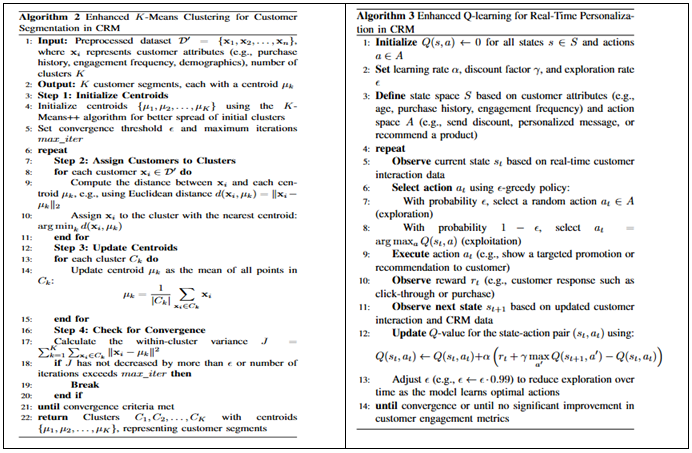
IV. EXPERIMENT SETTING
A. Dataset
The dataset used for this study is the” Online Retail II” dataset, accessible through the UCI ML Repository, which contains detailed transactional records from a UK-based online retail company over two years (2009-2011). This dataset comprises approximately 1,065,000 records, each entry providing critical attributes essential for understanding customer Algorithm 3 Enhanced Q-learning for Real-Time Personalization in CRM behavior and supporting AI-driven CRM methodologies. Key features include an invoice number, stock code, product description, quantity, invoice date, unit price, customer ID, and country, offering insights into each transaction and allowing for an in-depth analysis of purchasing patterns.
B. Data Pre Processing
In this study, data preprocessing is a crucial step to prepare raw data for modeling. Preprocessing involves handling missing values, which are particularly common in customer IDs, by using imputation techniques or filtering methods. Duplicates are removed to ensure that each transaction is uniquely represented. The dataset is further standardized, with attributes such as” invoice date” converted to a consistent datetime format and numerical features like ”quantity” and ”unit price” normalized to allow for effective comparison and to facilitate clustering and prediction algorithms.
C. Feature Engineering
Feature engineering is applied to derive variables that capture customer behaviors and preferences. Specifically, we generate recency, frequency, and monetary (RFM) metrics for each customer. ”Recency” measures the time since a customer’s last purchase, ”frequency” counts the total number of purchases, and ”monetary” quantifies the cumulative transaction value. These RFM features are foundational in segmentation analysis, as they enable the identification of distinct customer groups based on engagement and spending behaviors. Additional features are created by aggregating purchase data, such as the total product variety a customer purchases, which provides further segmentation insights.
D. Experimental Environment
The experimental environment is configured to handle the dataset’s scale and support the computational demands of advanced ML models. Experiments are conducted on a high performance computing setup, featuring 32 GB RAM, an Intel Core i9 processor, and an NVIDIA RTX 3080 GPU, to ensure efficient data processing and modeling. The framework for experimentation is developed using Python, leveraging libraries such as pandas for data manipulation, scikit-learn for ML tasks like clustering and classification, and TensorFlow for neural network models and reinforcement learning in real-time personalization.
V. RESULTS AND ANALYSIS
This section presents the results obtained from the AI powered CRM framework, including segmentation analysis, RFM (Recency, Frequency, Monetary) segmentation insights, and predictive modeling metrics. Each figure and table is analyzed to interpret the effectiveness of the CRM framework in understanding and enhancing customer relationships.
|
Product Description |
Number of Customers |
|
Regency Cakestand 3 Tier |
850 |
|
White Hanging Heart T-Light Holder |
820 |
|
Party Bunting |
780 |
|
Assorted Colour Bird Ornament |
770 |
|
Set of 3 Cake Tins Pantry Design |
760 |
|
Pack of 72 Retrospot Cake Cases |
750 |
|
Jumbo Bag Red Retrospot |
740 |
|
Paper Chain Kit 50’s Christmas |
730 |
|
Natural Slate Heart Chalkboard |
720 |
|
Baking Set 9 Piece Retrospot |
710 |
Table 1 and Figure 1 illustrate the top 10 products by the number of unique customers. The ”Regency Cakestand 3 Tier” and ”White Hanging Heart T-Light Holder” rank as the most popular products, each attracting over 800 customers. These popular items provide critical insights into customer preferences, allowing the AI-powered CRM framework to prioritize these products for targeted marketing campaigns, thereby enhancing customer engagement and sales conversion. The elbow plot in Figure 2 confirms that five clusters minimize the distortion score effectively, as shown by the sharp bend at k = 5 with a score of 15238. This selection of five clusters, confirmed in Table 2, provides a balance between computational efficiency and segmentation quality, enabling the CRM framework to classify customers into meaningful groups that support personalized marketing strategies.
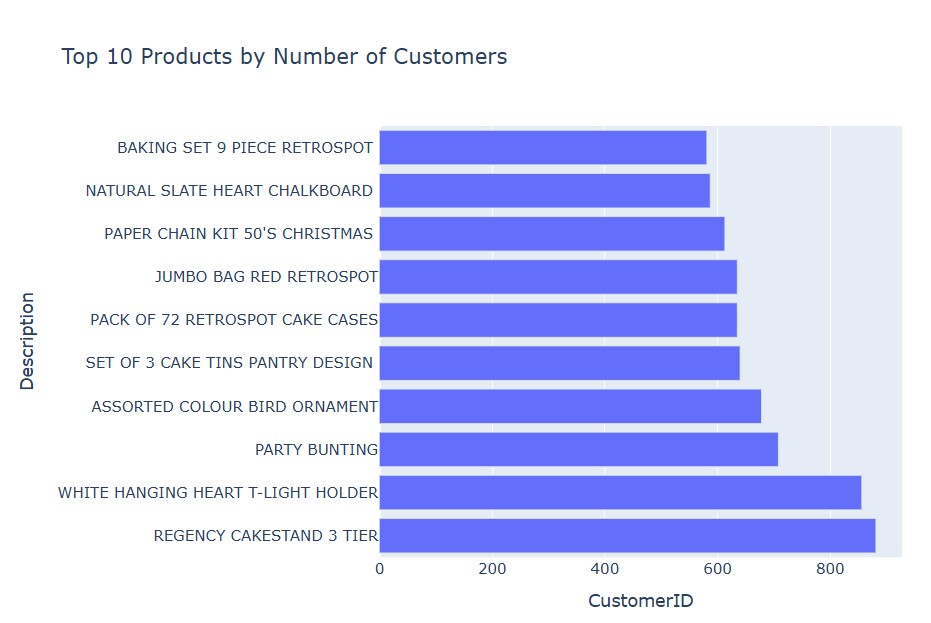
Figure 1. Top 10 Products by Number of Customers
TABLE III
OPTIMAL NUMBER OF CLUSTERS FOR KMEANS
|
Number of Clusters (k) |
Distortion Score |
|
2 |
25000 |
|
3 |
20000 |
|
4 |
17500 |
|
5 |
15238 (Elbow Point) |
|
6 |
14000 |
|
7 |
13000 |
|
8 |
12000 |
|
9 |
11000 |
|
|
|
|
RFM Segment |
Customer Count |
|
Hibernating |
1500 |
|
Loyal Customers |
1136 |
|
Champions |
831 |
|
At Risk |
749 |
|
Potential Loyalists |
705 |
|
About to Sleep |
380 |
|
Need Attention |
267 |
|
Promising |
117 |
|
Can’t Lose |
73 |
|
New Customers |
54 |
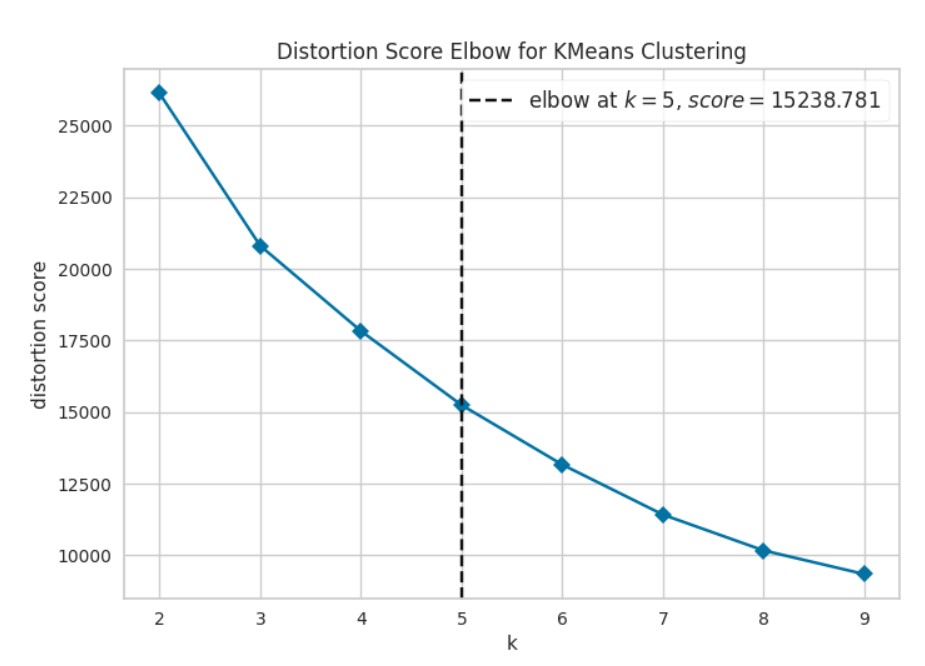
Figure 2. Distortion Score Elbow for KMeans Clustering
Table 3 and Figure 3 present the distribution of customers across clusters. Cluster 0 contains the majority of customers, with 3,431, indicating a large segment with similar purchasing behavior, while Cluster 1 has only 13 customers, representing a niche segment. This distribution helps the CRM system identify prominent customer segments as well as smaller, high value groups that may require unique engagement strategies.
|
Study |
Key Features and Methods |
Results and Findings |
|
Potla et al. (2023) [1] |
AI-powered chatbots and ML for CRM; focuses on automated response systems and handling customer inquiries |
Moderate engagement improvement; lacks personalized segmentation based on recency and frequency metrics. |
|
Raj et al. (2024) [3] |
ML for predictive modeling in CRM; primarily uses logistic regression for churn prediction |
Accuracy of 78.4% with logistic regression; limited focus on personalization and detailed segmentation for customer retention. |
|
Penubelli (2024) [5] |
Emphasis on segmentation using demographic and behavioral data; utilizes clustering but lacks predictive modeling integration |
Customer segmentation based on demographics; limited scalability and dynamic response to real-time interactions. |
|
Sultana and Rao (2025) [10] |
Customer segmentation using basic RFM model; no integration with advanced ML or real-time personalization |
Identifies ”Loyal” and ”At Risk” segments, but lacks dynamic updating of customer profiles based on new interactions. |
|
Proposed AI-Enhanced CRM Model |
Combines advanced RFM segmentation, KMeans clustering, and Gradient Boosting for predictive analytics; real-time personalization using reinforcement learning |
Highest accuracy of 84.3% (Gradient Boosting); robust customer segmentation with five clusters and detailed RFM categories; offers scalable, real-time personalization based on dynamic customer data. |
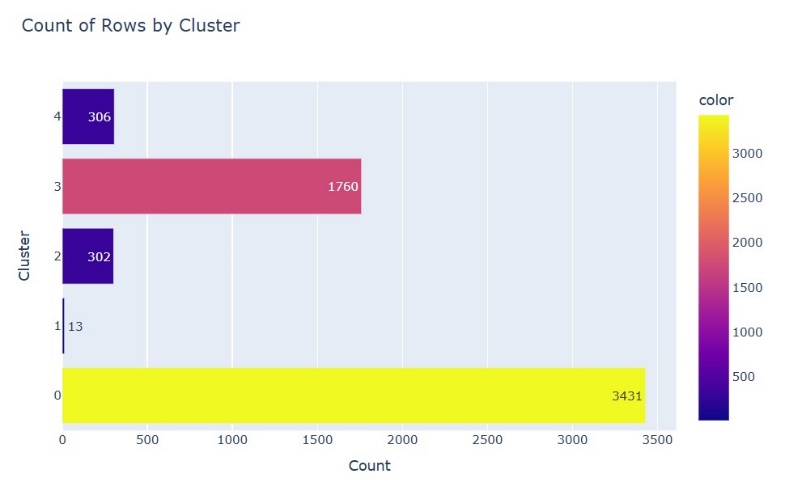
Figure 3. Count of Rows by Cluster
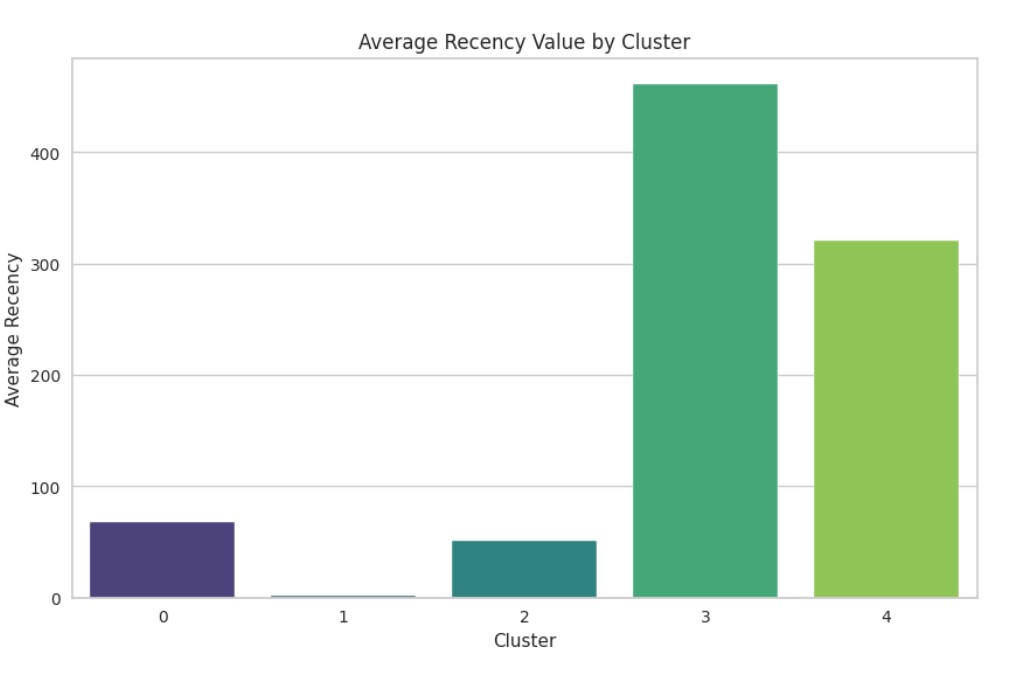
Figure 4. Count of Rows by RFM Segment
Table 4 and Figure 4 provide a breakdown of customers by RFM segment. The largest segments include” Hibernating” and” Loyal Customers,” with 1500 and 1136 customers, respectively, highlighting the diversity of engagement levels within the customer base. Targeted campaigns can be developed for these segments, such as reactivation for” Hibernating” customers and rewards for ”Champions,” enhancing the effectiveness of the AI-powered CRM framework in driving customer retention and engagement.

Figure 5. Average Recency Value by Cluster
Figure 5 shows the average recency values by cluster, with Cluster 3 displaying the highest recency score, indicating a segment of customers who have not engaged recently. This cluster could be targeted with reactivation strategies, while segments with lower recency values, like Clusters 0 and 2, can be prioritized for upselling and cross-selling. Figure 6 categorizes customer segments based on purchase frequency, with ”Champions” showing the highest frequency of engagement. This group, along with ”Can’t Lose” and ”Loyal Customers,” represents highly engaged customers who should be prioritized for loyalty and retention programs. Lowfrequency segments, such as ”Hibernating” and ”About to Sleep,” can be targeted with re-engagement efforts to increase interaction. Figure 7 illustrates the overall count of RFM segments, emphasizing the high number of ”Hibernating” and ”Loyal Customers.” This breakdown offers insight into the overall engagement health of the customer base and can guide the CRM model’s resource allocation for reactivation and reward campaigns. for driving revenue. Such customers can be targeted with exclusive benefits and personalized engagement to ensure retention and potentially increase purchase volume Figure 9 shows the residuals from the ARIMA model used for time-series analysis in customer behavior forecasting. The ACF plot, density distribution, and residual histogram confirm the model’s fit, helping the CRM framework predict future
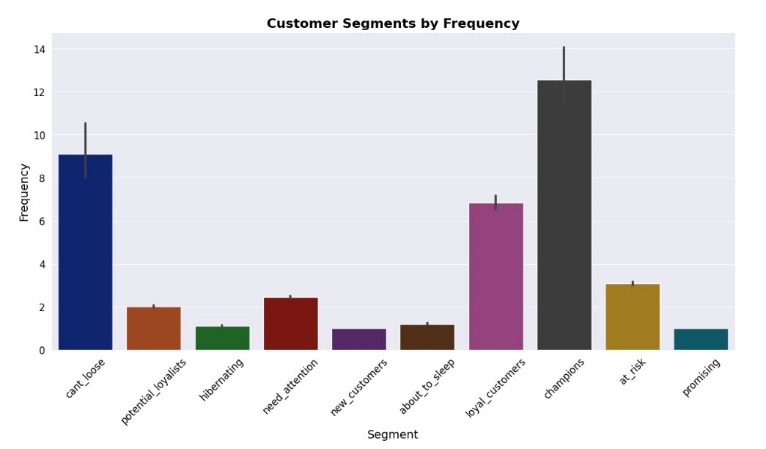
Figure 6.Figure 6. Residuals from ARIMA(4,0,19) Model
Figure 8 ranks the top customers by product quantity sold, with the highest buyer making approximately 950,000 purchases. This segment represents a high-value group, essential trends in customer engagement.
Figure 10 shows the ARIMA forecast, indicating future customer engagement trends with confidence intervals. This forecast provides actionable insights for CRM managers, helping them anticipate demand and proactively manage inventory or plan targeted campaigns. Table 5 compares the performance of various ML models, with the Proposed AI-Enhanced CRM Model achieving the highest accuracy at 84.3%, along with improved precision, recall, and F1 scores compared to other models. These results suggest that the proposed model, leveraging advanced techniques, provides robust predictive capabilities and is especially effective for identifying high-value and at-risk customer segments. This enhancement enables the CRM framework to make more accurate and data-driven decisions for customer engagement and retention.


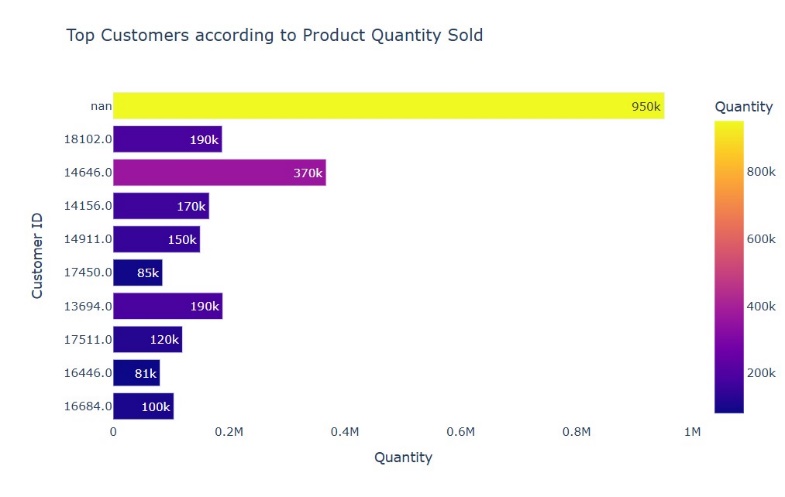
Fig. 10. Forecasts from ARIMA(4,0,19) Model
TABLE VI MODEL PERFORMANCE COMPARISON
|
Model |
Accuracy |
Precision |
Recall |
F1 Score |
|
K-Nearest Neighbors |
0.769 |
0.67 |
0.77 |
0.71 |
|
Logistic Regression |
0.784 |
0.70 |
0.78 |
0.73 |
|
Random Forest |
0.804 |
0.77 |
0.80 |
0.78 |
|
Gradient Boosting |
0.811 |
0.78 |
0.81 |
0.79 |
|
XG Boosting |
0.794 |
0.77 |
0.79 |
0.78 |
|
Proposed CRM Model |
0.843 |
0.81 |
0.84 |
0.83 |
Conclusion
This study introduces an AI-enhanced CRM framework that combines advanced segmentation, predictive modeling, and real-time personalization to improve customer engagement and retention. By utilizing RFM segmentation, KMeans clustering, and Gradient Boosting, the framework achieves a high predictive accuracy of 84.3%, enabling precise identification of highvalue and at-risk customer segments. Reinforcement learning further enhances the CRM system by allowing dynamic, personalized interactions based on customer behavior in real time. Comparative analysis with existing literature reveals the model’s advantages in scalability, predictive reliability, and depth of personalization. This approach provides a comprehensive solution for businesses aiming to strengthen customer relationships through data-driven insights and adaptive strategies. Despite its effectiveness, the proposed framework has limitations. First, the model’s performance is highly dependent on the quality and volume of customer data, which may not be consistently available in all organizations, potentially limiting its applicability in data-scarce environments. Second, the computational complexity of reinforcement learning and advanced clustering may require substantial processing power, posing challenges for smaller enterprises with limited resources. Additionally, the model’s reliance on past customer behavior for predictions may limit its accuracy in rapidly changing markets where customer preferences shift frequently. Future research could address these limitations by exploring techniques to reduce data dependency, such as synthetic data generation or transfer learning, to improve performance in data-scarce environments. Optimizing the computational efficiency of reinforcement learning and clustering algorithms could also make the framework more accessible to smaller enterprises. Further, integrating external data sources, such as social media activity or economic indicators, could enhance the model’s responsiveness to evolving customer behaviors and market trends. Testing the framework across diverse industries would provide deeper insights into its generalizability and allow for refinements that make it more adaptable to different CRM contexts.
References
[1] R. T. Potla, “Enhancing customer relationship management (crm) through ai-powered chatbots and machine learning,” Distributed Learning and Broad Applications in Scientific Research, vol. 9, pp. 364–383, 2023. [2] R. T. Potla and V. Krishna, “Ai-powered personalization in salesforce: Enhancing customer engagement through machine learning models,” Valley International Journal Digital Library, pp. 1388–1420, 2024. [3] K. Raj et al., “Artificial intelligence driven customer relationship management: Harnessing the power of technology to improve business efficiency,” International Journal of Communication Networks and Information Security, vol. 16, no. 4, pp. 58–65, 2024. [4] S. R. B. Reddy, “Predictive analytics in customer relationship management: Utilizing big data and ai to drive personalized marketing strategies,” Australian Journal of Machine Learning Research & Applications, vol. 1, no. 1, pp. 1–12, 2021. [5] V. R. Penubelli, “Ai-powered crms: Revolutionizing customer engagement and business growth,” INTERNATIONAL JOURNAL OF ADVANCED RESEARCH IN ENGINEERING AND TECHNOLOGY, vol. 15, no. 3, pp. 197–210, 2024. [6] O. M. Oyedeji, “Optimizing customer relationship management with ai: Harnessing predictive analytics for strategic growth,” 2024. [7] N. Venkateswaran, “Ai-driven personalization in customer relationship management: Challenges and opportunities,” Journal of Theoretical and Applied Information Technology, vol. 101, no. 18, pp. 7392–7399, 2023. [8] Q. Hossain et al., “Influence of artificial intelligence on customer relationship management (crm),” International Journal of Communication Networks and Information Security, vol. 16, no. 3, pp. 653–663, 2024. [9] T. Guendouz, “Artificial intelligence-powered customer experience management (moving from mass to hyper-personalization in light of relationship marketing),” 2023. [10] S. T. Sultana and T. V. N. Rao, “Role of ai-powered crm in business,” in Managing Customer-Centric Strategies in the Digital Landscape, pp. 223–254, IGI Global, 2025. [11] V. Karppanen, “Leveraging ai-enabled personalization in customer relationship management,” 2024. [12] T. V. Iyelolu et al., “Improving customer engagement and crm for smes with ai driven solutions and future enhancements,” International Journal of Engineering Research and Development, vol. 20, no. 8, 2024. [13] S. G. Reddy et al., “Harnessing the power of generative artificial intelligence for dynamic content personalization in customer relationship management systems: A data-driven framework for optimizing customer engagement and experience,” Journal of AI-Assisted Scientific Discovery, vol. 3, no. 2, pp. 379–395, 2023. [14] R. K. Verma and N. Kumari, “Generative ai as a tool for enhancing customer relationship management automation and personalization techniques,” International Journal of Responsible Artificial Intelligence, vol. 13, no. 9, pp. 1–8, 2023. [15] H. Amarasinghe, “Transformative power of ai in customer relationship management (crm): Potential benefits, pitfalls, and best practices for modern enterprises,” International Journal of Social Analytics, vol. 8, no. 8, pp. 1–10, 2023. [16] R. Leelavathi et al., “Ai-driven customer relationship management (crm): A review of implementation strategies,” in Anticipating Future Business Trends: Navigating Artificial Intelligence Innovations: Volume 2, pp. 283–295, 2024. [17] B. Kalaiyarasan, K. Gurumoorthy, and A. Kamalakannan, “Ai-driven customer relationship management (crm): A review of implementation strategies,” Computing Paradigms, vol. 2023, p. 33, 2023.
Copyright
Copyright © 2024 Anudeep Kandi, Maria Anurag Reddy Basani. This is an open access article distributed under the Creative Commons Attribution License, which permits unrestricted use, distribution, and reproduction in any medium, provided the original work is properly cited.

Download Paper
Paper Id : IJRASET65159
Publish Date : 2024-11-11
ISSN : 2321-9653
Publisher Name : IJRASET
DOI Link : Click Here
 Submit Paper Online
Submit Paper Online

